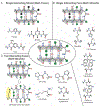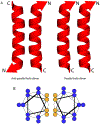Bent Into Shape: Folded Peptides to Mimic Protein Structure and Modulate Protein Function
- PMID: 33575525
- PMCID: PMC7875438
- DOI: 10.1002/pep2.24145
Bent Into Shape: Folded Peptides to Mimic Protein Structure and Modulate Protein Function
Abstract
Protein secondary and tertiary structure mimics have served as model systems to probe biophysical parameters that guide protein folding and as attractive reagents to modulate protein interactions. Here we review contemporary methods to reproduce loop, helix, sheet and coiled-coil conformations in short peptides.
Figures








References
Grants and funding
LinkOut - more resources
Full Text Sources
